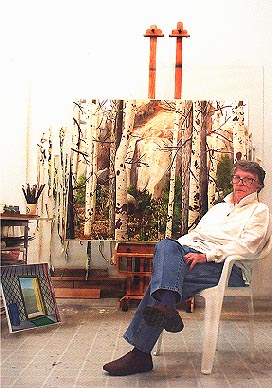
- Maud Gatewood
- Artist
- Yanceyville, North Carolina
- (1934-2004)
 |
|
She was a sheriff's daughter, and even in the rural isolation of Caswell County in the 1930s and '40s, Maud Gatewood found a critical eye and vast curiosity that served her well through a visual life. Her curiosity led her eye to cows grazing outside her childhood window, or to far-flung corners of the Earth riding camels, yaks and elephants. What she saw, she recorded on canvas.
All of it: Whether it was a crush of people storming a store for a sale; or a series of paintings of TV evangelists and politicians pandering for money -- one piece she titled "Profit/Prophet" -- or a stand of birch trees in Montana. Gatewood, one of North Carolina's best-known artists whose work hangs in museums and private collections across the country, died Monday. She had suffered two strokes recently and been unable to communicate. She was 70.
"Maud painted what she saw and she was a very keen observer," said longtime friend Dot Hodges, co-owner of a Charlotte gallery. "Nothing escaped her curiosity. She liked catching the instant." Gatewood, who lived in Chapel Hill, was born and raised in Yanceyville in Caswell County, where her father, Yancey Gatewood, was sheriff. At 10, she began to take art classes at Averett College in nearby Danville, Va. -- impressing teachers with her ability to see what most couldn't.
As a girl, she often rode shotgun with her father on patrols or moonshine still busts -- carrying a leather holster and toy gun. On a pony her father gave her, she found freedom beyond her picket-fence town, riding out to the farms and forests where she developed her lifelong appreciation for nature that constantly showed up in her work.
"She did believe there's order in nature," Hodges said. "She would look at things and find the natural patterns." Gatewood graduated from Woman's College (now UNC Greensboro) with a degree in fine arts in 1954 and earned a master's degree from Ohio State a year later. In 1963, she won a Fulbright grant to study art in Austria, under renowned painter Oskar Kokoschka.
Gatewood, never one to bite her tongue, found Kokoschka to be pompous and patronizing. "He would come around for a critique and offer the girls a bon-bon,"Hodges said. "When he got to Maud, she said: `I don't care for one of those, but I will take one of your cigarettes.' She thought his treatment was very degrading."
Returning, she came to Charlotte and to a fledgling art program at UNCC. She coordinated the program through its infancy, and left in 1973, deciding she needed more time to paint. After teaching part time at Central Piedmont Community College for two years, Gatewood moved back to Caswell County, where she was a county commissioner for years -- always the lone woman. She'd lovingly refer to the board as: "Just me and the boys." In Caswell County, she began cultivating her recognizable style, ranging from abstraction to realism, along with some figurative work and landscapes.
"You can always tell a Maud Gatewood painting," said Danville painter and longtime friend Robert Marsh. "She was daring. She'd have a stand of trees and then a diagonal comes out of nowhere. Who would do that, except for Maud?" She always impressed Marsh with her work ethic. If she wasn't painting, she was traveling. She got the adventure bug from her mother, Mary Lea, a world traveler. Often with Hodges, she traveled to India, Africa and China. "Even then she was storing up images," Marsh said.
During the 1970s, Gatewood was represented by two big-time New York galleries, but that didn't last long. "She was not as renowned as she should be, probably because she stayed in North Carolina," Hodges said. "She was a kind, generous soul." Yet she had a strong following, particularly in the Southeast. Her work hangs in the National Museum of Women in the Arts in Washington. She also won many prestigious awards, including the painting award from the American Academy of Arts and Letters in 1972 and the North Carolina Award in Fine Arts in 1984. Five years ago, UNC Greensboro gave her an honorary doctorate. Like many artists, Gatewood was not a great self-promoter. "Maud just wasn't built that way," said Chapel Hill gallery owner Joe Rowand, who represented Gatewood for 30 years. "She lived to paint; she didn't live to promote herself. She felt she was a decent painter, but she just didn't seek out notoriety."